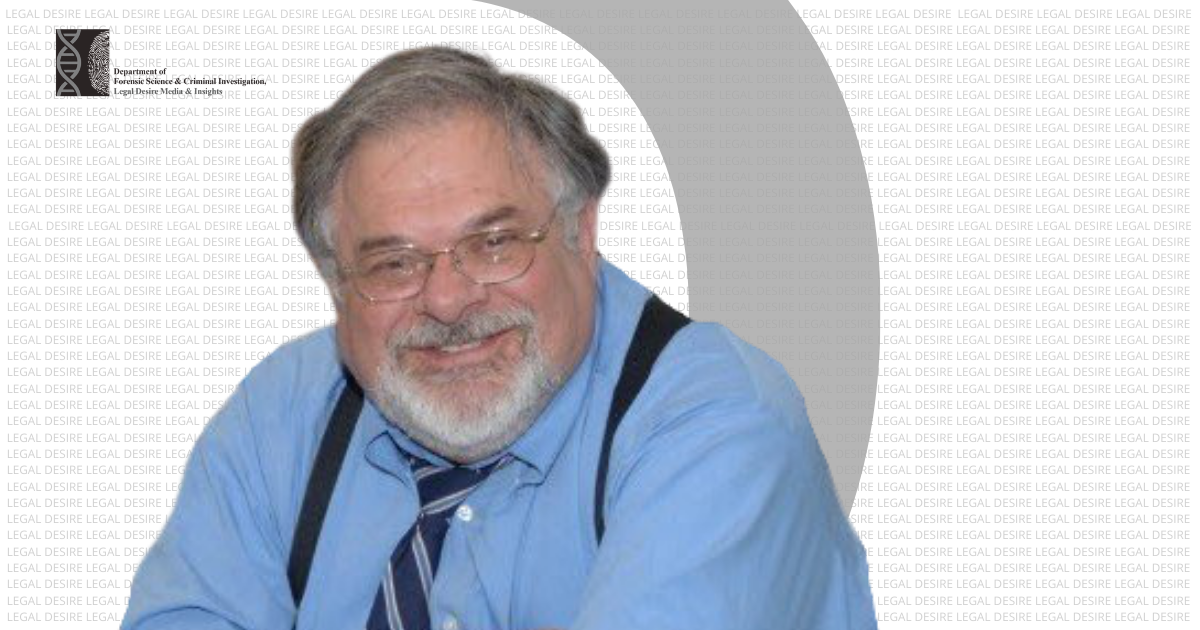Now Reading: In Conversation with Barry Fisher, Senior Forensic Science Consultant & Former Crime Lab Director
-
01
In Conversation with Barry Fisher, Senior Forensic Science Consultant & Former Crime Lab Director

In Conversation with Barry Fisher, Senior Forensic Science Consultant & Former Crime Lab Director
Barry A. J. Fisher served as the Crime Laboratory Director for the Los Angeles County Sheriff’s Department, a position he held from 1987 until his retirement in 2009. He began his career in criminalistics with the Sheriff’s crime lab in 1969 and worked in a wide variety of assignments. His current interests concern the interrelationship between forensic science and the law along with public policy issues concerning the timely delivery of quality forensic support services to the criminal justice system. He served as a member of the American Bar Association, Criminal Justice Section’s Ad Hoc Committee to Ensure the Integrity of the Criminal Process.
Fisher is a member of many professional organizations. He is a Distinguished Fellow and past-president of the American Academy of Forensic Sciences and was awarded the Academy’s highest award, the Gradwohl Medallion. He served as president of the International Association of Forensic Sciences, president of the American Society of Crime Laboratory Directors and a past chairman of the American Society of Crime Laboratory Directors – Laboratory Accreditation Board. He is a founding director and served on the Board of Directors of the National Forensic Science Technology Center from 1995 until 2007.
Fisher has been a member of several editorial boards: the Journal of Forensic Sciences, the Journal of Forensic Identification, Forensic Science Policy and Management, Forensic Science Research and the McGraw-Hill Encyclopedia of Science and Technology. Fisher is an alumni member of the Council of Scientific Society Presidents and a life member of the International Association of Chiefs of Police and was a member of the IACP’s Forensics Committee.
His textbook, Techniques of Crime Scene Investigation, in its 8th edition, enjoys wide popularity. He is a co-author of two other books, Forensics Demystified and Introduction to Criminalistics: The Foundation of Forensic Science. Fisher speaks throughout the United States and has lectured in Canada, England, Australia, Singapore, France, Israel, Japan, China, Turkey, Dubai, Portugal, India and Malaysia on forensic science laboratory practices, quality assurance, and related topics. In 2000, he led a forensic science delegation to lecture to forensic scientists in the People’s Republic of China. In 2012, he was invited again to China to lecture on forensic science developments in the United States. In 2017 he was invited to be a guest plenary speaker at a forensic science conference in Dubai.
Since retiring, Fisher has consulted for the United Nations Office on Drugs and Crime, the United States Department of Justice, International Criminal Investigative Training Program (ICITAP) and Analytic Services Inc., a not-for-profit institute that provides studies and analyses to aid decision-makers in national security, homeland security, and public safety. He also consults on forensic science matters.
Fisher grew up in the Bronx in New York City and received his Bachelor of Science degree in Chemistry from the City College of New York. He holds a Master of Science degree in Chemistry from Purdue University and an M.B.A. degree from California State University, Northridge. Barry and his wife Susan reside in Indio near Palm Springs, California. They have two married sons: David is a Professor of Practice and director of the New Jersey Institute of Technology Forensic Science Program, and Michael, an entrepreneur. He and Susan are the proud grandparents of eight grandchildren!
Interview:
- What inspired you to join the Forensics domain? Initially, how did you perceive the job profile?
It never occurred to me to be a forensic scientist. I studied chemistry in college and graduate school, earning a master’s of science degree. I met my future wife while in grad school and moved to Los Angeles. When I began looking for employment for a job in chemistry, I found there were few available that looked interesting to me. I had sent my resume to several places including the California Department of Human Resources, who contacted me about an opening at the Los Angeles County Sheriff’s Crime Lab. I applied, was accepted and began to work there on May 5, 1969.
- As the head of the Crime Lab, you might have had the responsibility of capacity building of the lab. How challenging was this task?
Building capacity: personnel, instrumentation and laboratory space was always a challenge. It was necessary to clearly lay out needs with strong arguments for fiscal support. The best way I found to work was to explain the laboratories needs in terms of policies our parent agency was concerned about. For example, if drug abuse and drug related crimes was the concern, we would explain how more personnel and update laboratory equipment would assist in the department’s efforts.
Additional laboratory work space was more complicated. One idea that worked was to move several sections of the laboratory out of the main laboratory into a satellite facility. Los Angeles County had some older, unused space that was at one time a clinical laboratory near a major County hospital. We were able to get funds to renovated the space.
A bigger problem was dwindling space at our main laboratory. We decided to collaborate with a found local university which has a Criminal Justice and Criminalistics Department. We also brought in another major regional crime laboratory, the Los Angeles Police Department’s Scientific Investigations Division into the concept. We recommended a joint use building on the university’s campus and were able to obtain $96M from the State government. That along with funds from Los Angeles County and Los Angeles City allowed up to build a facility for each of our organizations us.
- You have been affiliated to many organizations like American Academy of Forensic Sciences (AAFS), National Forensic Science Technology Center [NFSTC], American Society of Crime Laboratory [ASCLD] and many more. How did you manage to associate with these organizations despite having to work tirelessly for the lab?
Being involved with all of these organizations, in some cases as president (AAFS, ASCLD and IAFS) is challenging. I’ve always seen the value of collaboration with others in the profession. I was able to convince my superiors of the value of this sort of involvement and as long as I was able to get my job done at the laboratory, they were willing to allow me to be involved in these professional organization. Admittedly, it was a balancing act and somehow, I was able to accomplish it.
- Despite the casework at the lab, you contributed to the accreditation of the Crime Lab. How arduous was this process during those early days? According to you how does an accreditation help a Crime Lab?
I view laboratory accreditation as an essential aspect of running a modern forensic science laboratory. It is a daunting process to become an accredited laboratory. To accomplish it, I assigned a small team of forensic scientists to work on the details, of which there were many. Laboratory policies and procedures had to be in writing, quality assurance practices had to be clearly delineated and records had to be maintained of error made by the staff. Additionally, it was essential to have the laboratory staff willing to adopt the many changes required by accreditation standards.
- There might have been various instances, when you were called for inspecting the crimes scenes by the IO/Police Unit. How demanding was it to deal with it compared to the lab work?
During the early years at the laboratory, I was subject to call-out to major crime scenes – mainly murder cases. Often times these were during off duty hours and frequently in the very early morning hours which meant I had to dress and head out the laboratory, scene. Initially, I was unsettled at working around dead victims. But over time that passed. Often, when calls came in during working hours, I was engaged with some other work which had to be set aside in order to leave for the crime scene investigation. Los Angeles County had several high crime areas and it was not uncommon to have back-to-back callout. In such cases it was essential to have made good notes about each case so as not to confuse details.
- After the lab examination of the case evidences, you might have been called in the court of law on many instances as an expert witness in many normal and high-profile cases either from the Prosecutor/Defense side. What challenges were encountered by you while giving your opinion in the court and tips for giving a good expert testimony?
Before I started my career in forensic science, I was not especially good at public speaking. In fact, the prospect of speaking in public was frightening to me. Now I found myself in a profession where part of it required me to testify in court as an expert witness. My first few times were disconcerting. Over time I was able to overcome this problem, and began to look forward to testifying.
Nearly all my courtroom time was spent as a government witness. I can’t recall any case where I was a defense witness.
I recognized the juries tended to give a great deal of weight to what I testified to as an expert. Therefore, I took special care to explain my winding trying not to lean more to the prosecution or the defense. Testifying as an expert witness is an art. I had to learn what was acceptable and what was not permitted and not to become emotional involved when the “other side” tried to attack my credibility or my honesty as was sometime the case.
On occasion, I even tried to help a defense attorney out who was having difficulty in framing a question about what I did in my laboratory testing and my opinion.
- You have authored 3 books related to Forensic Science which intrigues many students, professors, lawyers & researchers all around the world, as it covers the theory as well the practical aspects. How do you see the success of your contribution? What do you think makes your book more loved and read by people?
I wrote these books for non-scientists (police investigators) to enable those entering into the field or as public safety persons who had occasion to use forensic science to understand how the testing was done and what sorts of interpretation might be reported. In addition, I devoted parts of the book to discussing some of the legal issues forensic scientists would be dealing with in the course of their carer as well as ethical consideration.
- Most of the professionals working at various forensic/crime labs are overburdened by the casework. But you managed to indulge into research work in spite of all this. What approach did you follow to make it possible and what challenges were encountered?
We did little research. Most state and local labs in the States focused on case work. At times we’d work on improving procedures but research was mainly done in university settings and federal labs such as the FBI, DEA, etc.
- It has been noted that a Crime/Forensic Laboratory receives an enormous amount of case exhibits for examination. As the head of the Crime Lab, how did you manage to handle the case exhibits from different cases? What approaches are required to clear the existing backlog and ensure that there is no delay in criminal prosecution?
Backlogs in cases is an ongoing challenge. We’ve tried to triage the cases and working the most serious ones first. However, political issues have often injected themselves into this model. For example, at one point, we decided to examine only cases where the prosecutor would change the perpetrator. The head of our police organization put an end to the scheme after political pressure from rape victims who argued that DNA test results might connect one case to others.
Often, we expended large amount of overtime to clear backlogs. But that is both costly and causes employee burnout. Finally, we always try for added staff. Sometimes that works and other times not. The downside of more staff is a need for added work space. We were able to enlist the aid of the California State government to aid us in the construction of a new facility which costed over $100M. This solution is the most problematic. Timing is everything and politicians have to be willing to offer that level of financial assistance.
- To recognize your outstanding contribution to the Forensic Science, you might have received appreciation letters, awards and recognition from the government as well as private organizations. What are some of them?
I’ve received a number of awards: from the County of Los Angeles, an outstanding service award; from the American Society of Crime Laboratory Directors, the Briggs White Awards for excellence in management; and the American Academy of Forensic Sciences the Gradwohl Medallion for the exceptional achievement in forensic sciences.
- Having worked for almost 4 decades in the Forensic Domain, do you still wish to contribute to this domain? How?
Absolutely. Once you’ve gotten the forensics “bug” it’s hard to stop being involved. Today, I am most happy to be a mentor to younger professional to help them out in their careers.
________________________________________________________________________________________________________________
Interviewed by Bhargav Rathod, Executive Assistant, Legal Desire Media & Insights.
Interview was published in Forensic Reporter March 2021 Issue.










